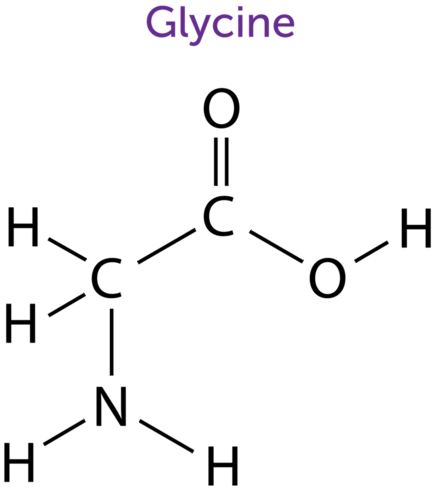6.10 蛋白锡
章节大纲
-
These pretty, colorful “ribbons” aren’t leftover ribbons from birthday gifts. The “ribbons” are a model of a molecule called hemoglobin, which is coursing through your blood vessels right now. Hemoglobin is a that is found in red blood cells and has the crucial job of carrying oxygen to cells throughout the body. Your life depends on hemoglobin.
::这些美丽的、多彩的“肋骨”并不是生日礼物留下的带子。 “肋骨”是一种分子的模型,叫做血红蛋白,它正在通过你的血管凝聚。 血红蛋白存在于红血细胞中,并且具有将氧气携带到整个身体细胞中的重要工作。 你的生活取决于血红蛋白。Meet the Proteins
::见到蛋白质Hemoglobin is a compound in the class of compounds called proteins. Proteins are one of four classes of , which are compounds in living things. (The other three classes are , , and .) Proteins contain carbon, hydrogen, oxygen, nitrogen, and sulfur. molecules consist of one or more chains of small molecules called amino acids.
::血红蛋白是被称为蛋白质的化合物类别中的一种化合物。蛋白质是四类化合物中的一种,它们是活物中的化合物。 (其他三个类别是,和.)蛋白质含有碳、氢、氧、氮和硫。分子由一种或多种称为氨基酸的小分子链组成。Protein Structure
::蛋白结构Amino acids are the “building blocks” of proteins. There are 20 different amino acids. The structural formula of the simplest amino , called glycine, is shown in the Figure . Other amino acids have slightly different structures. A protein molecule is made from one or more long chains of amino acids, each linked to its neighbors by . If a protein has more than one chain, the chains are held together by weaker bonds, such as .
::氨酸是蛋白质的“建筑块 ” 。 有 20 种不同的氨基酸 。 图中显示了最简单的氨基酸的结构公式(称为甘油 ) 。 其他氨基酸的结构略有不同 。 蛋白质分子是由一个或一个以上的氨基酸链制成的, 每一链都与邻里相连 。 如果蛋白质有多个链条, 链条由较弱的债券(如 ) 支撑在一起 。The sequence of amino acids in chains and the number of chains in a protein determine the protein’s shape. The shape of a protein, in turn, determines its function. Shapes may be very complex.
::氨基酸在链条中的序列和蛋白质中的链子数量决定蛋白质的形状。 蛋白质的形状反过来决定其功能。 形状可能非常复杂。Q: What do you think the “ribbons” in the colorful hemoglobin molecule pictured in the opening image represent?
::问题:您认为开张图像中描绘的多彩色血红蛋白分子中的“肋骨”是什么?A: The “ribbons” represent chains of amino acids.
::A:“肋骨”代表氨基酸链。Protein Functions
::蛋泰因函数Proteins are the most numerous and diverse biochemical compounds, and they have many different functions. Some of their functions include:
::蛋白质是数量最多、种类最多的生化化合物,具有许多不同功能。-
making up tissues as components of muscle.
::将组织组成肌肉的成分。 -
speeding up
as
.
::加速为 。 -
regulating life processes as hormones.
::将生命过程调节为荷尔蒙 -
helping to defend against infections as antibodies.
::帮助防止感染作为抗体。 -
carrying materials around the body as transport proteins (see the example of hemoglobin in the
Figure
).
::身体周围携带材料作为运输蛋白质(见图12中的血红蛋白)。
The blood protein hemoglobin binds with oxygen and carries it from the lungs to all the body’s cells. Heme is a small molecule containing iron that is part of the larger hemoglobin molecule. Oxygen binds to the iron in heme.
::血蛋白血红蛋白与氧结合,从肺中传到身体的所有细胞中。 Heme是一个小分子,含有铁,是更大的血红蛋白分子的一部分。 氧与 heme 中的铁结合。Summary
::摘要-
Proteins are one of four classes of biochemical compounds. Proteins contain carbon, hydrogen, oxygen, nitrogen, and sulfur.
::蛋白质是四类生化化合物之一,蛋白质含有碳、氢、氧、氮和硫。 -
A protein molecule is made from one or more long chains of amino acids, each linked to its neighbors by covalent bonds. Multiple chains of a protein are held together by weaker bonds.
::蛋白质分子是由一种或多种长链氨基酸制成的,每种氨基酸都通过共价债券与邻国相连。 多种蛋白质链由较弱的债券联在一起。 -
Proteins are the most numerous and diverse biochemical compounds. They have many different functions.
::蛋白质是数量最多、种类最多的生化化合物,具有许多不同的功能。
Review
::回顾-
What are proteins?
::什么是蛋白质? -
Describe the “building blocks” of protein molecules.
::描述蛋白质分子的“构件”。 -
What determines the shape of a protein? How is a protein’s shape related to its function?
::什么决定蛋白质的形状?蛋白质的形状如何与其功能相关? -
List three functions of proteins.
::列出蛋白质的三种功能。
-
making up tissues as components of muscle.


